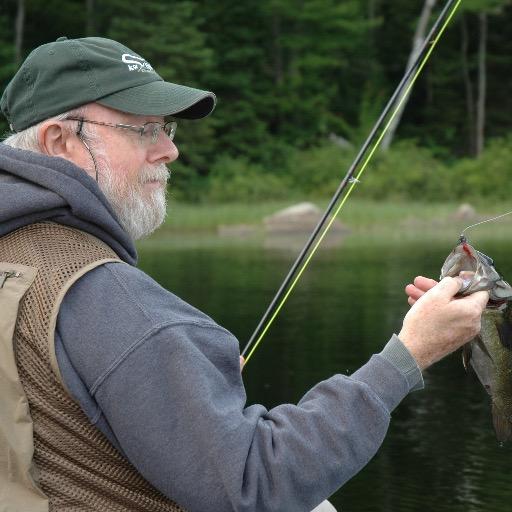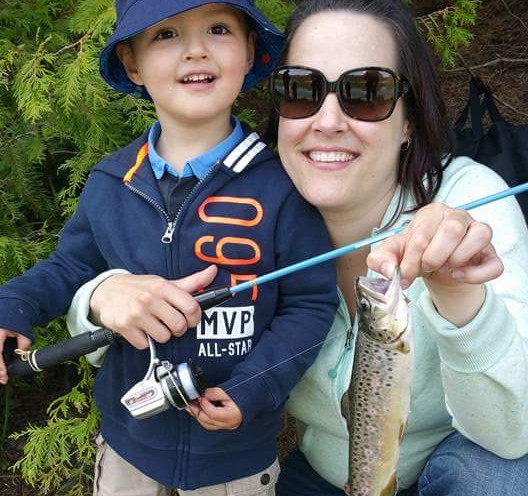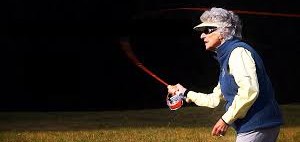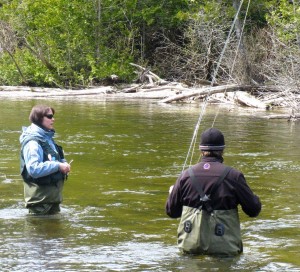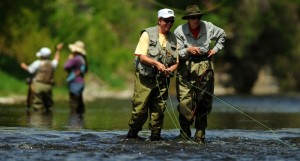With few exceptions, fly fishing has been an Old Boys’ Club. Not any more. Increasingly women are discovering the joys of what is variously referred to as a sport, a pastime, a recreation, a passion, an obsession or even a contemplation (with a nod to Sir Izaak).
Before proceeding I’d like to touch on a few of the exceptions to the fly fishing rule. This starts with a trip down history lane. While records of fly fishing date back to the height of the Roman Empire, the first work of Western literature devoted to the subject is the Book of St. Albans, printed in 1496, 57 years before the appearance of Izaak Walton’s The Compleat Angler.
If you doubt the endurance of recreational fishing in general, and fly fishing in particular, you might be surprised to know that Sir Izaak’s celebration of the art and spirit of fishing is the most frequently reprinted book of all time, save for the Bible and John Bunyan’s Pilgrim’s Progress. No wonder fly fishing is often packaged in quasi-religious or spiritual baggage.
What concerns us here is that an essay contained in the Book of St. Albans, titled A Treatyse of Fysshynge with an Angle, is attributed to Dame Julianna Berners, presumably a noblewoman who got thee to a nunnery, to paraphrase The Bard. I say attributed because the author remains lost in the mists of time. While there’s no verification that Dame Julianna wrote the Treatyse — let alone actually lived — the myth, mystique and romance of fly fishing insists we acknowledge her as the Mother of Fly Fishing, at least until proven otherwise. I, for one, have no problem with this assertion.
Authorship aside, fly fishing literature as it developed over time begins with the Treatyse. It’s been copied, quoted, bowdlerized and plagiarized throughout the ages — most notably by the wily Sir Izaak himself. Described by Robert Hughes in his delightfully informative and urgently cautionary memoir A Jerk on One End: Reflections of a Mediocre Fisherman as ‘the mother superior of limits and catch-and-release,’ Dame Julianna articulated the rules of etiquette that set the table for modern fly fishing, most succinctly summed up as equal parts ecological awareness and common decency. The ‘basic message’ in the Treatyse is ‘fishing is good for you [and] leads to health, long life and virtue,’ Hughes notes.
If we jump ahead to the early 20th century at the peak of the Golden Age of Fly Fishing centred in the Catskills, we learn that women were seen on trout streams with fly rod in hand more often after the First World War, according to Austin M. Francis in Catskill Rivers. Subtitled Birthplace of American Fly Fishing, the book lists some of the most prominent female fly anglers including: Theodore Gordon’s mysterious companion who accompanied him on the Neversink River and remains unidentified to this day; Louise Miller, celebrated in her husband Sparse Grey Hackles’ Fishless Days, Angling Nights; Maxine Atheron, wife of John, author of the classic The Fly and the Fish; and Joan Wulff, a master fly caster who continues operating a fly fishing school in the Catskills after the death of her husband, legendary fly angler Lee Wulff.
The present brings us to a couple of Canadians: April Vokey, host of Shorelines on the World Fishing Network, and Rebecca Redd, a host of The New Fly Fisher TV show. Both have been named ambassadors of The American Museum of Fly Fishing .
Fly fishing is celebrated for the quality of writing that has been devoted to the pastime since Dame Julianna. While men have most often picked up quill or pen, or sat down at the typewriter or keyboard, more women than ever are writing about fly fishing from a female perspective. Three books I happen to have in my library include:
• Little Rivers: Tales of a Woman Angler, by Margot Page who at the time of publication was editor of the American Fly Fisher, the journal of The American Museum of Fly Fishing.
• Green River Virgins and Other Passionate Anglers, a collection of short stories by Mallory Burton, an American-born teacher, linguist and fly angler who at the time of publication lived in Prince Rupert, B.C.
• Moose in the Water, Bamboo on the Bench: A Journal and a Journey, by Michigan-raised Kathy Scott, examines the subculture of split-cane rod makers and the anglers who cast bamboo as their rod of choice.
We’ve all heard stories of fly fishermen who were introduced to fishing by their fathers, grandfathers, older brothers, uncles or other significant males. The stories of how female fly anglers came to fishing, while fewer and less familiar, are nonetheless life-changing.
The stories of a quartet of female fly anglers from southwestern Ontario confirm my point. I met all four while I was a reporter for the Waterloo Region Record. Although I covered arts and entertainment, I took every opportunity — despite the objections of a scrupulously vindictive editor-in-chief — to write about fly fishing, a passion that overtook me in my mid-50s when I had been at the newspaper for a couple of decades. The article was featured as the cover story of the June, 2010 issue of Grand magazine.
There are no more prominent women fly anglers in southwestern Ontario than Sherri Steele and Heather Jones, otherwise known as the Robins Twins from the days before they married. They started fishing at a young age and have become well-known in fly fishing circles by introducing the sport to other women.
They learned the rudiments of casting fur and feather from their mother, Sue, whose legacy they play forward through their love of the pastime that brought their parents together in the first place.
Marriage and childbirth usually draw mothers and daughters closer together. Sherri and Heather always had a strong bond with their mom. However, they were denied the opportunity of connecting on a deeper level when they married. And neither will have their mom at their side when they give birth.
All of which makes the identical twins, who were raised in Stratford, deeply grateful for fly fishing. ’These are things we should have shared with our mom,’ Sherri observes. ‘Fly fishing gave us what we wouldn’t have had otherwise.’
The cold, bright stars seemed in alignment for their mother on 22 February, 2007. Six weeks earlier, the elementary school teacher had joined her husband, Ken, in retirement. Just three days earlier, the couple had celebrated their 37th anniversary. And they were packed to leave for Florida, where they looked forward to enjoying their favourite pastime — fly fishing.
The night before heading south, Sue visited her mother in a nursing home outside Stratford. She wouldn’t think of going away without dropping in, even though her mom was suffering from dementia and wouldn’t recognize her daughter.
Then the stars melted into tears. Upon leaving the nursing home, Sue was engulfed in a harsh snowstorm. As she was leaving the parking lot, her car was struck by an oncoming vehicle.
Her death at age 55 was not only a devastating blow to her family and friends, it plunged Ontario’s fly fishing community into a collective state of mourning. Canadian Fly Fisher, which at the time was Canada’s leading magazine devoted to the sport, honoured her life with a moving memorial tribute.
Sue was a leader among a growing number of women to discover the deep delights fly fishing. Not only was it integral to her life, she was a popular instructor passionately committed to introducing women to the sport. Now her daughters carry on the tradition by conducting workshops, seminars and clinics.
Female fly fishers – or women interested in taking up the sport – are blessed to live in southwestern Ontario. There are numerous rivers brimming with trout, bass, steelhead, pickerel, pike, even muskie, within a couple hours’ drive of Waterloo Region, including the Grand, Credit, Thames, Maitland and Saugeen rivers. There are also quality fly shops and established clubs including KW Flyfishers which has a number of female members.
Sandy Root and Beth Stormont, both of Dundas, Ont., taught courses and hosted weekend retreats for female fly anglers organized by Grand River Troutfitters, the fly shop in Fergus that has been replaced by Grand River Outfitting & Fly Shop. Troutfitters continues as an online guide and instructional service.
Born and raised in Rockwood, Sandy fished from an early age with her six brothers at their cottage in Algonquin Park. ‘I fished all my life,’ she says. ‘It came naturally.’ Her mother established a summer outdoor camp in Rockwood when her children were teenagers. Sandy followed her mother’s example in 1995 by forming Down to Earth, an environmental education business.
Both Sandy and Beth were introduced to fly fishing when they took streamside workshops more than a decade ago. A couple of years later, they attended a five-day course at Canadore College in North Bay.
Born in Toronto, Beth moved to Kitchener when she was three. After graduating from teachers’ college, she was hired by the Hamilton Conservation Authority, where she oversees outdoor education and outreach programs. She fished ‘for as long as I can remember,’ but got away from it in her teens. A trip to the Yukon about 15 years ago reignited her interest in fishing, which eventually led to fly-fishing.
Sue and Ken Robins went fishing on their first date in 1970. They honeymooned in Northern Ontario while pursuing brook trout, before teaching one another the rudiments of fly fishing by sharing a library copy of Joe Brook’s seminal book Trout Fishing. ‘When mom met dad, she quickly realized she would have to learn to fly fish if they were going to spend time together,’ Heather recalls.
As Ken, a high school science teacher, acquired the knowledge and skills of an expert fly angler (he wrote a chapter on brook trout in The Fishing Book: Sportfishing in Ontario, published in 1990), Sue held her ground alongside her husband and, in the process, developed instructional programs for women.
Heather, a University of Waterloo graduate, is a high school math teacher in Stratford, where she lives with husband Jonathan Jones, an elementary school teacher. Meanwhile, Sherri and husband, Nick Steele, live in Barrie, where she is a medical science professor at Georgian College. She completed her doctorate at the University of Toronto after graduating from the University of Guelph.
The Robins Twins — as they are still known among area fly fishers — fished for perch with spinning rods soon after they started walking. They agree their dad insisted that, ‘the family that fishes together, stays together,’ Heather confirms.
Their infectiously enthusiastic parents never tired of regaling their daughters with tales of fly fishing adventure. ‘We grew up listening to their memories of spending nine weeks fly fishing in Alaska,’ Sherri recalls.
The twins, who have been fly fishing since their dad built them custom rods when they were seven, remember their parents packing them into the car and heading out to Montana when they were 13 years old. ‘Our parents said it was the best place to fly fish, hot and dry,” Sherri remembers. ‘When we got there, the weather was awful, it was the coldest, wettest summer in memory. The fishing wasn’t great, but we still had a wonderful time.’
Although Sue could have taught her daughters the basics of fly fishing, she deferred to her husband. ‘Mom could have done it, but she wanted dad to do it,’ Sherri notes. Initially, the instructive sessions allowed Ken to bond with his daughters; but as they grew older, they turned to their mother. ‘We really became friends with mom through fly fishing,’ Heather observes.
Not only did the twins fish with their mom, they joined her in teaching fly fishing. They assisted in clinics and workshops, including Ontario Out of Outdoors’ Spring Fishing Show, Ontario Federation of Anglers & Hunters’ Women’s Outdoor Weekend and Izaac Walton Fly Fishing Club’s Canadian Fly Fishing Forum, in addition to Grand Opportunities, organized annually at the Belwood Lake Conservation Authority by Friends of the Grand River (where I first met them).
They also followed in their mother’s footsteps by participating in Casting for Recovery, founded in the U.S. by a female oncologist as a therapeutic program for women recovering from breast cancer. ‘Our relationship deepened when we began teaching with mom,’ Heather says.
The twins honour their mother’s memory by adopting her teaching methods. ’People always say how much we look like our mom, but it’s more than a physical resemblance,” Sherri asserts. ‘We teach fly fishing the same way mom taught it. Mom wanted women to experience the joy and wonder and delight of fly fishing. She wanted women to realize it isn’t a sport just for men.’
‘Our goal is bringing women to fly fishing,” Heather adds. “It’s not about skill sets or technicalities, but love of the sport.’
Sue taught through the art of narrative. She had a reputation as an irrepressible storyteller, which her daughters have inherited. ‘Since mom passed away, we have women returning to our workshops two or three times because they want to hear the stories,” Sherri confirms. ‘Women love hearing the stories of other women.’
‘We tell mom’s stories,’ Heather adds. ‘Her stories live on through us.’
When asked to identify the attractions of fly fishing, the twins enthusiastically reel off numerous qualities and elements.
‘It’s something you can do cheaply,’ Sherri offers pragmatically. ‘Mom and Dad didn’t have a lot of money. It was something we could do inexpensively as a family.’ (Enthusiasts new to the sport can set themselves up with good quality gear — rod, reel, line, waders wading boots, vest, hemostats, clippers, leaders, tippets and box of flies — for less than $1,000).
Fly fishing is an active, rather than passive, pastime, even though it’s low impact in terms of stress on the body. ‘It’s not a boring sport because you’re always doing something,’ she adds. ‘It’s not like sitting on a river bank and staring at a worm and bobber or sitting in a boat and trolling.’
Heather is drawn to the sport’s mystique. ‘We felt special because it wasn’t something a lot of people did. Being girls, it was really neat. . . . We were proud to tell people we enjoyed it.’ She also appreciates the peacefulness and serenity of fly angling. ‘It puts you in intimate contact with nature.’
Sandy and Beth couldn’t agree more. Sandy explains, ‘fly fishing maintains a closer connection to nature’ than fishing with natural bait (worms, minnows, crayfish, leeches, grasshoppers) or hard tackle (lures, crank baits, spinners, spoons or plastic materials). She believes catching a fish on an artificial fly — especially one the angler has tied — is sacramental. ‘It’s a blessing for a fish to choose one of my flies.’
Beth contends that fly fishing is respectful of nature through such conservation practices as barbless hooks and catch-and-release. ‘I love catching and releasing fish, so they continue growing to old age.’ She finds fly fishing ‘aesthetically appealing’ in response to the sport’s contemplative, meditative, Zen-like quality. ‘When you first learn to fly fish you get frustrated, but eventually anxiety is replaced with expectation and contentment. It’s like stepping out of your mind and out of time.’
The intimate connection to the water has a meditative, restorative quality many writers — including Norman Maclean in A River Runs Through It — describe as spiritual. ‘A river is like a home you are invited to enter,’ Sandy says. ‘Once you learn how to read water, you get to know where the fish live. It’s as if they welcome you.’
The four anglers agree women approach fly fishing differently than men. They also agree it’ s easier to teach women. (All of the male fly fishing instructors and guides I’ve talked to concur).
‘Our mom wanted women to get over the intimidation,’ Heather says. ‘But it wasn’t a political thing.’ Sherri adds, ‘Women have fewer preconceptions than men. Men see fly fishing as a power thing.’
Sandy concurs: ‘Men talk about how many fish they catch and how large they are.’
In contrast, women place more value on the existential experience. ‘Women take their time on the water, they don’t race from place to place, they savour the silence and follow the river’s pace and rhythm.’
Although you can learn the basics in an afternoon, fly fishing is an enriching life-long process of learning. The sport is based on body rhythm and touch. And, as Sandy confirms, perfectionism isn’t required. ‘It takes you to a quiet place of grace.’
Sherri and Heather don’t fish together as much as they used to. It took their dad some time before he returned to the passion he shared so long with his wife.
Even though their husbands don’t fly fish — at least for now — their eyes sparkle when they talk about fly fishing together again; when it’s time to teach their children the graceful art of casting an artificial fly on tranquil waters.
When the twins were young, their parents purchased a trailer on the Saugeen River to accommodate the family devotion to fly fishing. Their ‘home’ water — a term dear to all anglers — was chosen as their mother’s final resting place. ‘Mom’s ashes were dispersed on the river,” Heather says. ‘When light dances on the water and gives it a twinkle, we think of her,” Sherri adds. ‘We feel her presence on the water.’
Fast forward to 2016. I have been unable to reach Sandy and Beth for an update; however, it’s been a period of change and transition for Sherri and Heather. Here’s an update from Sherri:
Sherri and Nick moved to Guelph two years ago. She now teaches in the Life Sciences Department at Sheridan College. She has a three-year-old son Parker and a six-month-old daughter Piper Susan. Heather and Jon still live in Stratford, where she continues to teach high school. She has a five-year-old daughter Avery and a three-year-old son Gavin, born a week after Parker.
Not surprisingly, ‘fly fishing has been placed on the backburner,’ Sherri confirms, adding that she and Heather have been fly fishing only ’a handful of times’ in recent years. Instructing has also been put on hold for the time being.
However, Parker caught his first trout on a spin-casting outfit this year. Similarly, both Avery and Gavin fish. While neither husband has taken up fly fishing, both enjoy the outdoors, leaving their wives to pass their love of the sport along to their children. ‘I can’t wait for when we’ll be able to teach fly fishing to our kids, just like mom taught us,’ Sherri affirms. ‘It’ll be pretty special.’
(Featured image shows Sherri with son Parker after he landed his very first trout — a momentous occasion, to be sure)

